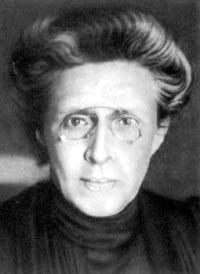Preceded by Mirza Davud Huseynov Name Elena Stasova Succeeded by Grigory Kaminsky Role Polit. | Parents Dmitri Stassov Preceded by Office established | |
 | ||
Died December 31, 1966, Moscow, Russia Similar People Kliment Voroshilov, Andrei Grechko, Mikhail Kalinin, Semyon Timoshenko, Vladimir Lenin | ||
Elena Dmitrievna Stasova (3 October 1873 – 31 December 1966) was a Russian communist revolutionary who became a political functionary working for the Communist International (Comintern). She was a Comintern representative to Germany in 1921. From 1927 to 1938 she was the president of International Red Aid (MOPR). From 1938 to 1946 she worked on the editorial staff of the magazine International Literature.
Contents
Early years
Elena Stasova was born in St. Petersburg, Russia in 1873 to an ethnic Russian family. She was the daughter of a liberal jurist, Dmitry Stasov (1828–1918) who worked in the Senate and was a Herald at the coronation of Alexander II. Her grandfather had been architect to Tsars Alexander I and Nicholas I. Her uncle was art critic Vladimir Stasov.
After finishing secondary school, Elena became a committed socialist and joined the Russian Social Democratic Workers Party (RSDRP) at the time of its establishment in 1898.
When the RSDRP split into Bolshevik and Menshevik factions in 1903, Stasova cast her lot with Lenin and the Bolsheviks as a professional revolutionary. Over the next two years Stasova adopted the pseudonyms "Absolute" and "Thick" and served as the conduit for Lenin's newspaper, Iskra, in St. Petersburg, where she worked as party secretary of that city. She taught new members how to encode and decode. Stasova also served as secretary of the Northern Bureau of the Bolshevik Central Committee, and in other leading party positions. Other pseudonyms which Stasova used during the underground period included "Delta," "Heron," "Knol," and "Varvara Ivanovna."
Stasova emigrated to Geneva, Switzerland in 1905, where she was at the time of the Russian Revolution of 1905. She returned home in January 1906 to direct Bolshevik work in Tiflis (now Tbilisi), the capital of Georgia.
In January 1912, Stasova was elected as an alternate member of the Bolshevik party's Central Committee. She was then secretary to the party's Russian bureau. This was followed in 1913 by arrest and exile to Siberia, where she remained until 1916. She had left the party treasury with her brother.
Political career
After the February Revolution of 1917, Stasova was named a secretary of the Central Committee — a position which she retained through the October Revolution, finally standing down in March 1920. She was also returned as an alternate member of the Bolshevik Central Committee by the 6th Congress of the Russian Communist Party in 1917. She was elected to full membership on the CC by the 7th Congress of 1918 and the 8th Congress of 1919. However, the 9th Congress of 1920 dropped her both from the Central Committee and from the party secretariat.
After being removed from the Central Committee, Stasova worked for the Petrograd party organization, from where she was brought into the Comintern's apparatus. She was appointed Comintern representative to the Communist Party of Germany (KPD) in May 1921, where she used the pseudonym "Hertha." Stasova remained in Germany through 1926, where she played a leading role in the German affiliate of the International Red Aid (MOPR) organization, Die Rote Hilfe.
Stasova returned to the USSR in February 1926. The next year she was named deputy director head of the international MOPR as well as head of the Central Committee of the MOPR organization in the USSR, positions which she retained through 1937.
Stasova served as a member of the Central Control Commission of the Russian Communist Party from 1930 to 1934 and in 1935 the 7th World Congress of the Comintern named her a member of the International Control Commission. She retained this position until the Comintern was dissolved in 1943.
Stasova, unlike so many other "Old Bolsheviks," was untouched by the spy mania and secret police terror which swept the Soviet Union in the late 1930s, but she was moved in 1938 to a new position on the editorial staff of the magazine International Literature. Stasova continued in this role until 1946, when she retired.
Death and legacy
Elena Stasova died on 31 December 1966.
A boarding school for foreigners in Ivanovo, Russia called the Ivanovo International Boarding School ("Interdom"), established by MOPR in 1933, was named after Elena Stasova.
